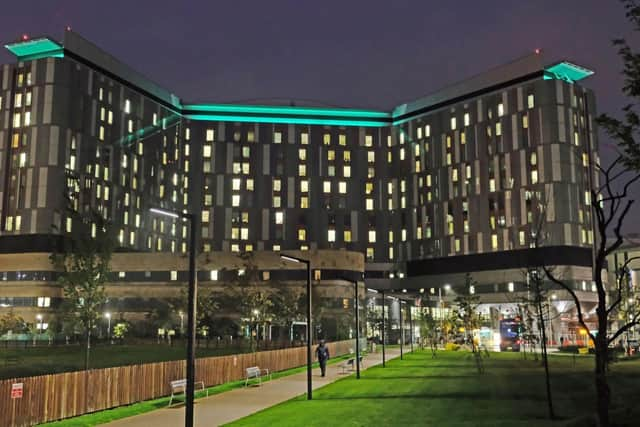Scottish Hospitals Inquiry: Doctor says she did not sign off on plans for children’s ward at Queen Elizabeth University Hospital
Professor Brenda Gibson, a consultant paediatric haematologist, gave evidence to the inquiry on Monday, which is investigating a series of contamination issues at the £840 million Queen Elizabeth University Hospital (QEUH) in Glasgow.
Scottish ministers announced the inquiry in the wake of deaths linked to infections at the hospital, including that of ten-year-old Millie Main, who was being treated for cancer at the children’s hospital that is part of the same campus.
Advertisement
Hide AdAdvertisement
Hide AdThe inquiry is also examining problems that led to the delay in the opening of the new Royal Hospital for Children and Young People in Edinburgh.


Professor Gibson told Alister Duncan KC, the inquiry’s senior counsel, that she did not sign off on plans because they had not got the hospital they were promised.
And the professor, lead of the Schiehallion children’s cancer unit, said she still does not know what happened at QEUH to cause infections in a children’s ward
Prof Gibson said: “There are two versions of what’s happened. There is a real environmental problem [and] there’s no environmental problem at all. I still don’t know which is true.
“All I can say is we have had our £11m refurbishment and we now have what is said to be the best ventilation system that money can buy and we have got water that is coming out of a post-filter tap which has no bacteria in it.”
Mr Duncan asked Prof Gibson if she had ever had an answer to what was happening from the very highest level. She replied: “No.”
Prof Gibson said the responsibility for providing a safe environment for patients lay with the health board. Her unit had been based at Yorkhill in the city, and plans were drawn up for it to be moved. Prof Gibson said there had been “very limited consultation”.
“All that I remember we had as choices was there was a floor plan, and that was to be our space, and we were not to have any more space than that,” the inquiry heard.
Advertisement
Hide AdAdvertisement
Hide Ad“We could do anything related to that space, but if it didn’t meet our needs, it couldn’t be extended. So we just had to make the most of that space and we opted to maximise the number of patient cubicles.”
It meant at the new hospital, she told the inquiry, they had to “sacrifice” much of what had been at the old unit to fit patients to avoid them being sent to other wards and, as a result, lost office space, parent accommodation, a staff room, a seminar room, and pharmacy accommodation.
“I, as the lead, was asked to sign off the plan and I didn’t do it,” she said. “Well, I didn’t do it to the best of my knowledge. I certainly held out for a very long time.
“I think it was signed off by a senior nurse, a managerial nurse. That’s my understanding.” And, the inquiry heard: “We had been promised a like-for-like unit in a flagship hospital and it certainly wasn’t a like-for-like unit.”
Contamination issues have been linked with water quality and ventilation systems in the super-hospital, which opened in April 2015.
Prof Gibson told the hearing, which is being overseen by inquiry chairman Lord Brodie, she had no involvement with ventilation or water systems. She said her team’s involvement was “purely in deciding how we would allocate the space”.
During the hearing, Prof Gibson said it was the view of clinicians they were “responsible for providing chemotherapy or any other form of care within national or international protocols or guidelines, and to do that with a well-trained workforce within a holistic manner”.
She added: “The responsibility for providing a safe environment for that treatment to be delivered lies, within our view, with the health board led by the chief executive. The responsibility for deciding – is a place safe or not safe – lies with control of infection.”
Advertisement
Hide AdAdvertisement
Hide AdUpon moving into the hospital, the inquiry heard, there were sewage leaks, cladding issues, and windows falling out. The inquiry also heard there were issues with temperature, blinds, televisions not working, and also issues with the smell of a nearby sewage treatment works.
Prof Gibson is the lead clinician for the haematology and oncology service based in the Royal Hospital for Children in Glasgow.
In April 2015, the QEUH campus in Glasgow opened, but has been blighted by a number of contamination incidents, linked to issues with water quality and ventilation systems at the £840m campus.
An independent review into the hospital's design published its findings in June 2020, concluding some patients had been "exposed to risk that could have been lower". However, it found no "sound" evidence there had been "avoidable" deaths.
The review team said the hospital campus now "has in place the modern safety features and systems that we would expect".
Meanwhile, the RHCYP in Edinburgh was due to open in July 2019, but was delayed after last-minute inspections found safety concerns over its ventilation systems.
The Scottish Government then stepped in to prevent the hospital from opening just one day before it was due to accept patients.
When the inquiry was first announced in September 2019, former health secretary Jeane Freeman said the hospital would not be fully operational for at least another year.
Advertisement
Hide AdAdvertisement
Hide AdThe hospital was officially opened on March 23, 2021. To get to that point, however, £80m extra was spent on "enabling and equipment works" at the site outwith the main contract, an estimated £28m fixing the ventilation and the delays in opening the hospital, and a further £11.6m given to contractor IHSL to end a 2017 dispute over construction standards.
Comments
Want to join the conversation? Please or to comment on this article.